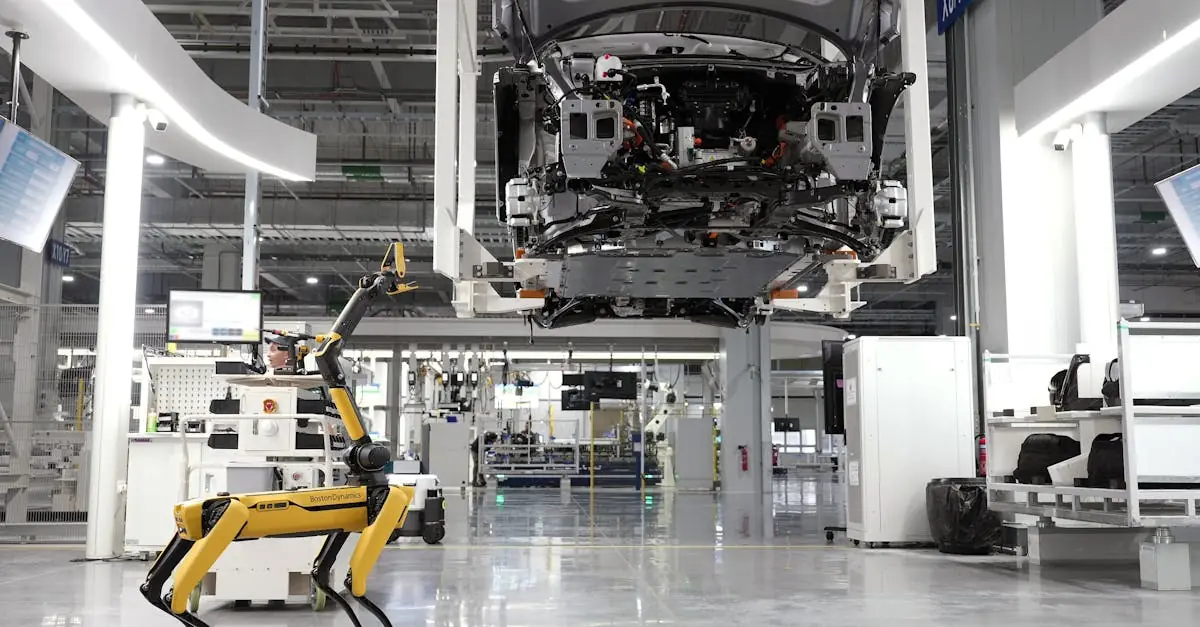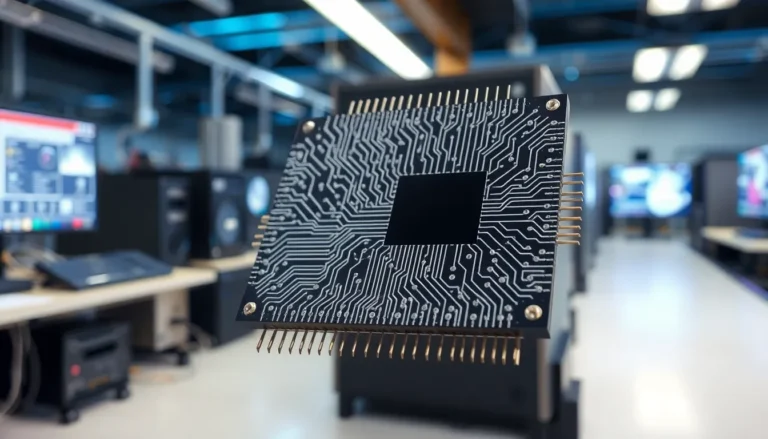Imagine a world where your toaster can chat with your fridge while your smart thermostat adjusts the temperature based on your mood. Welcome to the dazzling realm of 5G and the Internet of Things (IoT). This dynamic duo isn’t just a tech geek’s dream; it’s the backbone of a smarter, more connected future.
Table of Contents
ToggleOverview of 5G and IoT
5G stands as the fifth generation of mobile network technology, providing faster speeds and reduced latency compared to previous generations. Internet of Things, or IoT, describes the network of interconnected devices that communicate and exchange data. These two technologies combine to create smarter environments in homes, cities, and industries.
Data rates in 5G can reach up to 10 Gbps. In contrast, IoT devices rely on lower bandwidth needs for efficient communication. Latency in 5G can drop to as low as 1 millisecond, ensuring real-time interactions between devices. This immediate responsiveness plays a critical role in sectors like healthcare, where timely data transfer can save lives.
Integration of 5G and IoT enhances automation and efficiency across various applications. Smart cities leverage these technologies for traffic management, improving public safety and reducing congestion. In agriculture, IoT sensors monitor soil conditions while 5G networks transmit that data instantly, enabling farmers to optimize resource usage.
Security remains a key concern in this evolving landscape. 5G networks introduce new vulnerabilities, highlighting the necessity for robust encryption and authentication protocols. As more devices connect, managing data privacy and security becomes paramount.
Collaboration between industries accelerates innovation in 5G and IoT. Telecommunications companies invest in infrastructure upgrades, while tech firms develop IoT solutions tailored to leverage 5G capabilities. This partnership fosters advancements in AI and machine learning, further enhancing device functionality.
The combination of 5G and IoT promises not just a leap in connectivity, but a profound transformation in how society interacts with technology. Each connected device contributes to a broader ecosystem, facilitating smarter, more efficient everyday operations.
Benefits of 5G for IoT
5G technology brings substantial advantages to the Internet of Things ecosystem. These benefits include enhanced connectivity and reduced latency, which play crucial roles in device performance and user experience.
Enhanced Connectivity
Enhanced connectivity offers a significant improvement in device interaction. 5G networks connect millions of devices simultaneously, vastly surpassing previous generation capabilities. This scalability supports the growing demand from smart homes, cities, and industrial applications. A smooth, continuous flow of data streams between devices fosters real-time communication, allowing for efficient automation. For instance, smart traffic lights communicate with connected vehicles, optimizing traffic flow and reducing congestion. Reliable connections contribute significantly to the functionality and effectiveness of IoT applications.
Reduced Latency
Reduced latency represents a game-changer for IoT deployments. 5G networks can achieve latency as low as 1 millisecond, enabling instantaneous data exchange. This rapid response time is crucial for applications requiring immediate feedback, such as remote surgeries and automated manufacturing processes. In these scenarios, split-second decisions directly influence outcomes and efficiency. Moreover, reduced latency enhances the user experience in gaming and virtual reality applications, making interactions seamless and immersive. Fast response times empower IoT devices to react promptly to environmental changes, improving overall system performance.
Challenges of 5G and IoT Integration
Integrating 5G with IoT presents several challenges that impact efficiency and security.
Infrastructure Limitations
Infrastructure limitations significantly hinder 5G and IoT integration. Many regions lack the necessary network capabilities to support widespread 5G coverage. High costs associated with building new towers and upgrading existing ones create barriers to implementation. Many devices may not be compatible with advanced 5G networks. Interoperability issues can lead to communication breakdowns between various IoT devices. Network congestion can arise with millions of devices connected simultaneously, causing slowdowns in data transfer. Effectively addressing these infrastructure gaps is critical for realizing the full potential of 5G and IoT combined.
Security Concerns
Security concerns are a major obstacle in the integration of 5G and IoT. New vulnerabilities emerge with the deployment of 5G technology, exposing devices to cyberattacks. Data privacy remains a pressing issue as vast quantities of personal information traverse these networks. Many IoT devices lack adequate encryption, making them easy targets for hackers. Moreover, the complexity of managing numerous interconnected devices amplifies the risk of security breaches. Implementing strong cybersecurity measures and protocols is essential to safeguard user data and maintain trust in these technologies.
Applications of 5G in IoT
5G technology significantly enhances the capabilities of IoT applications across various sectors. This synergy creates opportunities for increased efficiency and connectivity.
Smart Cities
Smart cities leverage 5G to improve urban living and management. Real-time data collection helps optimize traffic flows, reduce congestion, and enhance public transportation efficiency. High-speed connectivity allows streetlights to adjust based on traffic patterns, fostering energy savings. Enhanced surveillance systems utilize low-latency connections for quicker responses to incidents, ultimately improving public safety. Furthermore, smart waste management systems enable sensors to notify services when bins are full, optimizing collection routes. The interconnectedness of devices fosters a more streamlined urban landscape.
Industrial Automation
5G empowers industrial automation by streamlining operations and enhancing productivity. Factories utilize IoT devices connected to 5G networks for real-time monitoring of machinery conditions. Data analytics then informs maintenance schedules, reducing downtime significantly. Robotics operating on these networks achieve precise coordination, resulting in smoother workflows. Moreover, remote monitoring capabilities enable quick intervention in case of equipment failures. Increased data transfer speeds allow for the seamless integration of AI, facilitating predictive analytics for improving efficiency. This combination transforms traditional manufacturing into a more agile and responsive environment.
Future Trends in 5G and IoT
Innovations in 5G and IoT technology will drive future applications and services. Enhanced connectivity enables real-time data exchange, significantly benefiting healthcare, transportation, and manufacturing sectors. Smarter homes integrate devices, allowing seamless communication between everyday appliances. Interconnected systems increase energy efficiency, improving overall sustainability.
In smart cities, technologies powered by 5G optimize public services. Intelligent traffic management systems reduce congestion, while smart waste management enhances resource allocation. Comprehensive data analytics leads to better urban planning, creating communities that adapt to resident needs.
Industrial automation is evolving alongside 5G deployment. Real-time monitoring of machinery improves operational efficiency, while predictive maintenance decreases downtime risks. Robotics integration enhances productivity, resulting in agile manufacturing processes.
Security solutions are paramount as vulnerabilities emerge. Organizations prioritize encryption technology and regular software updates, aiming to protect sensitive data. Robust cybersecurity frameworks will build trust among users of connected devices.
Collaboration across sectors intensifies, with partnerships shaping the IoT landscape. Telecommunications firms upgrade infrastructure alongside tech companies developing specialized IoT applications. This cooperation encourages continuous advancements in artificial intelligence and machine learning, enhancing device capabilities further.
Investments in infrastructure emphasize low-latency connections, positioning 5G as the backbone of future connectivity. Potential breakthroughs in smart agriculture showcase how IoT sensors can optimize resource use. Such innovations exemplify the transformative power of these technologies, impacting everyday experiences profoundly.
The fusion of 5G and IoT is set to revolutionize how people interact with technology in their daily lives. As devices become more interconnected the potential for smarter homes cities and industries expands significantly. This integration not only enhances efficiency and automation but also paves the way for innovative applications that can transform various sectors.
However the journey isn’t without challenges. Security concerns and infrastructure limitations must be addressed to ensure a safe and reliable experience. Continued collaboration among industries will drive advancements and foster the development of robust solutions.
Ultimately the promise of 5G and IoT lies in their ability to create a more intelligent and connected world where technology seamlessly integrates into everyday life.




